Squamous trans-differentiation of pancreatic cancer cells promotes stromal inflammation
- PMID: 32329713
- PMCID: PMC7200154
- DOI: 10.7554/eLife.53381
Squamous trans-differentiation of pancreatic cancer cells promotes stromal inflammation
Abstract
A highly aggressive subset of pancreatic ductal adenocarcinomas undergo trans-differentiation into the squamous lineage during disease progression. Here, we investigated whether squamous trans-differentiation of human and mouse pancreatic cancer cells can influence the phenotype of non-neoplastic cells in the tumor microenvironment. Conditioned media experiments revealed that squamous pancreatic cancer cells secrete factors that recruit neutrophils and convert pancreatic stellate cells into cancer-associated fibroblasts (CAFs) that express inflammatory cytokines at high levels. We use gain- and loss-of-function approaches to show that squamous-subtype pancreatic tumor models become enriched with neutrophils and inflammatory CAFs in a p63-dependent manner. These effects occur, at least in part, through p63-mediated activation of enhancers at pro-inflammatory cytokine loci, which includes IL1A and CXCL1 as key targets. Taken together, our findings reveal enhanced tissue inflammation as a consequence of squamous trans-differentiation in pancreatic cancer, thus highlighting an instructive role of tumor cell lineage in reprogramming the stromal microenvironment.
Keywords: TP63; cancer biology; cancer-associated fibroblasts; human; human biology; inflammation; medicine; mouse; pancreatic cancer; squamous; trans-differentiation.
© 2020, Somerville et al.
Conflict of interest statement
TS, GB, JD, SH, XH, KV, KM, YX, DM, OK, OD, JP, MH, ME No competing interests declared, DT an advisor to Surface, Leap, and Cygnal and has stock ownership in Surface and Leap, CV has received funding from Boehringer-Ingelheim and is an advisor to KSQ Therapeutics.
Figures



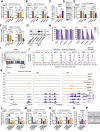
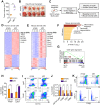
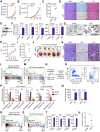
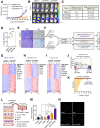
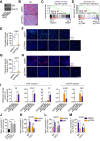
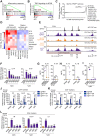
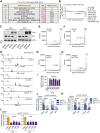


Similar articles
-
Meflin-Positive Cancer-Associated Fibroblasts Inhibit Pancreatic Carcinogenesis.Cancer Res. 2019 Oct 15;79(20):5367-5381. doi: 10.1158/0008-5472.CAN-19-0454. Epub 2019 Aug 22. Cancer Res. 2019. PMID: 31439548
-
Saa3 is a key mediator of the protumorigenic properties of cancer-associated fibroblasts in pancreatic tumors.Proc Natl Acad Sci U S A. 2018 Feb 6;115(6):E1147-E1156. doi: 10.1073/pnas.1717802115. Epub 2018 Jan 19. Proc Natl Acad Sci U S A. 2018. PMID: 29351990 Free PMC article.
-
Mesenchymal Plasticity Regulated by Prrx1 Drives Aggressive Pancreatic Cancer Biology.Gastroenterology. 2021 Jan;160(1):346-361.e24. doi: 10.1053/j.gastro.2020.09.010. Epub 2020 Sep 30. Gastroenterology. 2021. PMID: 33007300
-
Crosstalk between Tumor and Stromal Cells in Pancreatic Ductal Adenocarcinoma.Int J Mol Sci. 2020 Jul 31;21(15):5486. doi: 10.3390/ijms21155486. Int J Mol Sci. 2020. PMID: 32752017 Free PMC article. Review.
-
Key players in pancreatic cancer-stroma interaction: Cancer-associated fibroblasts, endothelial and inflammatory cells.World J Gastroenterol. 2016 Mar 7;22(9):2678-700. doi: 10.3748/wjg.v22.i9.2678. World J Gastroenterol. 2016. PMID: 26973408 Free PMC article. Review.
Cited by
-
MUC16 and TP53 family co-regulate tumor-stromal heterogeneity in pancreatic adenocarcinoma.Front Oncol. 2023 Feb 3;13:1073820. doi: 10.3389/fonc.2023.1073820. eCollection 2023. Front Oncol. 2023. PMID: 36816942 Free PMC article.
-
PDAC as an Immune Evasive Disease: Can 3D Model Systems Aid to Tackle This Clinical Problem?Front Cell Dev Biol. 2021 Dec 10;9:787249. doi: 10.3389/fcell.2021.787249. eCollection 2021. Front Cell Dev Biol. 2021. PMID: 34957115 Free PMC article. Review.
-
Heterocellular OSM-OSMR signalling reprograms fibroblasts to promote pancreatic cancer growth and metastasis.Nat Commun. 2021 Dec 17;12(1):7336. doi: 10.1038/s41467-021-27607-8. Nat Commun. 2021. PMID: 34921158 Free PMC article.
-
Distinct mechanisms of innate and adaptive immune regulation underlie poor oncologic outcomes associated with KRAS-TP53 co-alteration in pancreatic cancer.Oncogene. 2022 Jul;41(28):3640-3654. doi: 10.1038/s41388-022-02368-w. Epub 2022 Jun 14. Oncogene. 2022. PMID: 35701533
-
Pathology and Molecular Characteristics of Pancreatic Cancer.Surg Oncol Clin N Am. 2021 Oct;30(4):609-619. doi: 10.1016/j.soc.2021.06.003. Epub 2021 Jul 22. Surg Oncol Clin N Am. 2021. PMID: 34511185 Free PMC article. Review.
References
-
- Albrengues J, Shields MA, Ng D, Park CG, Ambrico A, Poindexter ME, Upadhyay P, Uyeminami DL, Pommier A, Küttner V, Bružas E, Maiorino L, Bautista C, Carmona EM, Gimotty PA, Fearon DT, Chang K, Lyons SK, Pinkerton KE, Trotman LC, Goldberg MS, Yeh JT, Egeblad M. Neutrophil extracellular traps produced during inflammation awaken dormant Cancer cells in mice. Science. 2018;361:eaao4227. doi: 10.1126/science.aao4227. - DOI - PMC - PubMed
-
- Andreu P, Johansson M, Affara NI, Pucci F, Tan T, Junankar S, Korets L, Lam J, Tawfik D, DeNardo DG, Naldini L, de Visser KE, De Palma M, Coussens LM. FcRgamma activation regulates inflammation-associated squamous carcinogenesis. Cancer Cell. 2010;17:121–134. doi: 10.1016/j.ccr.2009.12.019. - DOI - PMC - PubMed
-
- Bailey P, Chang DK, Nones K, Johns AL, Patch AM, Gingras MC, Miller DK, Christ AN, Bruxner TJ, Quinn MC, Nourse C, Murtaugh LC, Harliwong I, Idrisoglu S, Manning S, Nourbakhsh E, Wani S, Fink L, Holmes O, Chin V, Anderson MJ, Kazakoff S, Leonard C, Newell F, Waddell N, Wood S, Xu Q, Wilson PJ, Cloonan N, Kassahn KS, Taylor D, Quek K, Robertson A, Pantano L, Mincarelli L, Sanchez LN, Evers L, Wu J, Pinese M, Cowley MJ, Jones MD, Colvin EK, Nagrial AM, Humphrey ES, Chantrill LA, Mawson A, Humphris J, Chou A, Pajic M, Scarlett CJ, Pinho AV, Giry-Laterriere M, Rooman I, Samra JS, Kench JG, Lovell JA, Merrett ND, Toon CW, Epari K, Nguyen NQ, Barbour A, Zeps N, Moran-Jones K, Jamieson NB, Graham JS, Duthie F, Oien K, Hair J, Grützmann R, Maitra A, Iacobuzio-Donahue CA, Wolfgang CL, Morgan RA, Lawlor RT, Corbo V, Bassi C, Rusev B, Capelli P, Salvia R, Tortora G, Mukhopadhyay D, Petersen GM, Munzy DM, Fisher WE, Karim SA, Eshleman JR, Hruban RH, Pilarsky C, Morton JP, Sansom OJ, Scarpa A, Musgrove EA, Bailey UM, Hofmann O, Sutherland RL, Wheeler DA, Gill AJ, Gibbs RA, Pearson JV, Waddell N, Biankin AV, Grimmond SM, Australian Pancreatic Cancer Genome Initiative Genomic analyses identify molecular subtypes of pancreatic Cancer. Nature. 2016;531:47–52. doi: 10.1038/nature16965. - DOI - PubMed
Publication types
MeSH terms
Substances
Associated data
- Actions
- Actions
- Actions
Grants and funding
- P20 CA192996/CA/NCI NIH HHS/United States
- R01 CA190092/CA/NCI NIH HHS/United States
- U10CA180944/CA/NCI NIH HHS/United States
- P20 CA192994/CA/NCI NIH HHS/United States
- U01 CA224013/CA/NCI NIH HHS/United States
- 5P01CA013106-Project 4/CA/NCI NIH HHS/United States
- 5P50CA101955/CA/NCI NIH HHS/United States
- P30 CA045508/CA/NCI NIH HHS/United States
- U01 CA210240/CA/NCI NIH HHS/United States
- P01 CA013106/CA/NCI NIH HHS/United States
- T32 CA009476/CA/NCI NIH HHS/United States
- R01 CA188134/CA/NCI NIH HHS/United States
- 16-20-25-VAKO/PCAN/Pancreatic Cancer Action Network/United States
- R01 CA229699/CA/NCI NIH HHS/United States
- P50 CA101955/CA/NCI NIH HHS/United States
- 1R01CA190092/CA/NCI NIH HHS/United States
- U10 CA180944/CA/NCI NIH HHS/United States
LinkOut - more resources
Full Text Sources
Medical
Molecular Biology Databases
Research Materials
Miscellaneous

